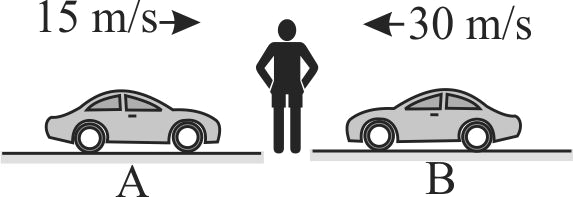354761
\(A\) and \(B\) are two sources generating sound waves. \(A\) listener is situated at \(C\). The frequency of the source at \(A\) is \(500\;Hz\). A, now, move towards \(C\) with a speed \(4\;m/s.\) the number of beats heard at \(C\) is 6 . When \(A\) moves a way from \(C\) with speed \(4\;m/s\), the number of beats heard at \(C\) is 18 . The speed of sound is \(340\;m/s\). The frequency of the source at \(B\) is:
354761
\(A\) and \(B\) are two sources generating sound waves. \(A\) listener is situated at \(C\). The frequency of the source at \(A\) is \(500\;Hz\). A, now, move towards \(C\) with a speed \(4\;m/s.\) the number of beats heard at \(C\) is 6 . When \(A\) moves a way from \(C\) with speed \(4\;m/s\), the number of beats heard at \(C\) is 18 . The speed of sound is \(340\;m/s\). The frequency of the source at \(B\) is:
354761
\(A\) and \(B\) are two sources generating sound waves. \(A\) listener is situated at \(C\). The frequency of the source at \(A\) is \(500\;Hz\). A, now, move towards \(C\) with a speed \(4\;m/s.\) the number of beats heard at \(C\) is 6 . When \(A\) moves a way from \(C\) with speed \(4\;m/s\), the number of beats heard at \(C\) is 18 . The speed of sound is \(340\;m/s\). The frequency of the source at \(B\) is:
354761
\(A\) and \(B\) are two sources generating sound waves. \(A\) listener is situated at \(C\). The frequency of the source at \(A\) is \(500\;Hz\). A, now, move towards \(C\) with a speed \(4\;m/s.\) the number of beats heard at \(C\) is 6 . When \(A\) moves a way from \(C\) with speed \(4\;m/s\), the number of beats heard at \(C\) is 18 . The speed of sound is \(340\;m/s\). The frequency of the source at \(B\) is:

